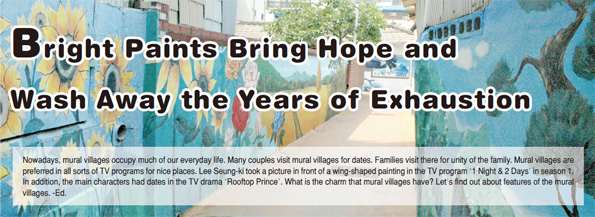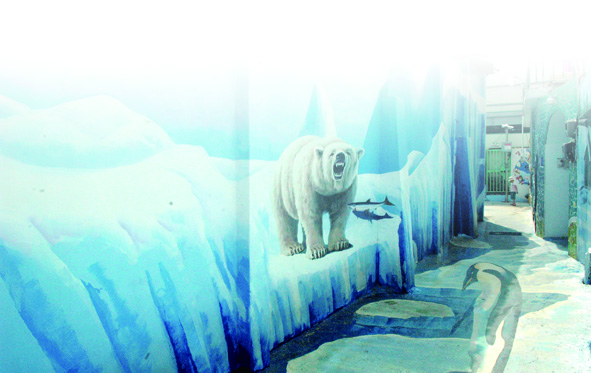Nowadays, mural villages occupy much of our everyday life. Many couples visit mural villages for dates. Families visit there for unity of the family. Mural villages are preferred in all sorts of TV programs for nice places. Lee Seung-ki took a picture in front of a wing-shaped painting in the TV program ‘1 Night & 2 Days’ in season 1. In addition, the main characters had dates in the TV drama ‘Rooftop Prince’. What is the charm that mural villages have? Let’s find out about features of the mural villages. -Ed.

Mural villages have special characteristics. Mural villages contain memories. When you amble next to the murals, you could fall into old memories. This would help you escape from the complications of reality. Moreover, mural villages have the power to help people overcome a crisis. It can change a crisis into an opportunity. The representative mural villages that have those characteristics are Minari Street mural village and Dongpirang mural village.
First village, Cheonan Minari Street
There are local memories in the mural villages. We can reach ‘Cheonan Minari Street’ in about 50 minutes in a vehicle from Cheongju. When we take a step into Minari Street, we can face another world.
Minari Street has a lot of murals which depict the past. We can see the familiar scene where children follow the vehicle which sprays insecticide. There are also murals based on the region. A dragon shape, the symbol of Cheonan, was drawn on the wall. Moreover, Cheonan’s typical farm produce, pears and rice, were drawn on the mural.
The end of the alley connects to the old market. We can see the old market’s traces on the wall. However, this is not the end. There is art to attract children. It seems like we are in the arctic because chilly ice, a polar bear and penguins are finely drawn on the wall. From the beginning of the alley to the end of the alley, there are old scenes, interesting art and various pictures depicted on the wall, so all visitors without distinction of sex or age can enjoy it.
Second village, Tongyeong Dongpirang
There is hope, which is to change a crisis into an opportunity, in the mural villages. Behind the Tongyeong harbor, there is a village on a towering hill where people can see anywhere in Tongyeong. It is ‘Dongpirang village’. Dongpirang village holds a mural contest every two years, so new paintings are drawn on the walls. Therefore, numerous visitors flow in and out of Dongpirang village to see various murals.
Originally, it was in crisis because it was selected as a redevelopment area in the past. The village came close to being eliminated entirely. However, if this place was eliminated entirely, there would have been some problems. Most residents have small incomes. Furthermore, they couldn’t take the government’s compensation because most houses were shanty houses. The organization ‘Pureun Tongyeong 21’ realized this problem. They changed Dongpirang village to a mural village. The theme of the village was ‘The Alley That Has Color and Paintings’. Therefore, hope came into the Dongpirang village, which was once filled with despair. Now, tens of thousands of people across the nation visit there for drawing or viewing. That has led to the growth of the regional economy. By this change, Dongpirang village was designated as a preservation area and not a redevelopment area. Song Han(’12, Dept. of Safety Engineering), who was originally from Tongyeong, said about the changes of Dongpirang village, “This place was a poor hillside village, so nobody paid attention to it. After the beautiful mural was drawn in the village, many people visited here. I am surprised that Dongpirang village has become a tourist attraction as it represents Tongyeong.” There is also Ssamji Park and Ssamji educational site for the visitors. Visitors can experience various programs such as hand painting at Ssamji educational site.
Making a painting on the wall together
The mural villages were made in 2006 by the government for the first time. Before that, urbanization was rapidly happening in Korea, so many people couldn’t realize the value of the natural environment, the cultures, or the art. Finally, national interest was spread about the fine views of the cities after the 1988 Olympic Games and the Korea-Japan World Cup in 2002 were held. The Korean government changed the old walls into beautiful walls through a public art project in 2006. The participants of the project were painters and local inhabitants. Actually, murals were usually drawn by painters or the inhabitants of the villages, but people who are not actually concerned with the villages also can be participants. Furthermore, people can participate in painting on the walls through joining local events or joining volunteer clubs occasionally. Lee Sang-yeop, who experienced painting the walls in Cheonan, said about the limitations of volunteer participation, “Most industries of painting the walls held by the Ministry of Culture, Sports and Tourism limit participants’ range to just painters and local inhabitants. However, recently, many college clubs or companies are running special activities including painting walls, so people can experience it more easily.” For college students, one of the representative clubs of painting the walls is ‘Dreaming Brush’.
Please be full of consideration
As mural villages have been popular through the media, the number of people who want to go there is increasing. However, people should think about who the real owners of the villages are. Tourists visit the village just to see murals, but inhabitants who are living in the village face too many people in a day. Some inhabitants are proud of this, while other inhabitants feel sick and tired of this. For example, at Ewha mural village in Seoul, there was an example where an exhibition of the village’s pictures was canceled because of a protest by the inhabitants because they felt uncomfortable about their houses being shown to other people. Another example is Suamgol, the famous village with a painting on the wall in Cheongju. In Suamgol, the people who wanted to see the shooting of the drama ‘Jaein of Glory’ in 2011 crowded there, so there was too much noise. For preventing this, a notice board read, “Please control coming in and out after 9 p.m”. Furthermore, one tourist even invaded the inhabitant’s front yard after going over the wall.
Visiting mural villages has advantages. One is giving joyful experiences to tourists, and the other is improving the local economies. However, the method of seeking joy must not harm other people. If people consider the inhabitants’ situations when visiting the village, both visitors and local inhabitants can be satisfied.

By Oh Ah-ra
By Kim Ji-won
jw34@cbnu.ac.kr


 All
All Culture
Culture






 Oh Ah-ra & Kim Ji-won
Oh Ah-ra & Kim Ji-won











